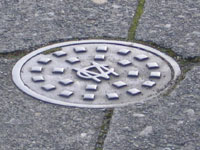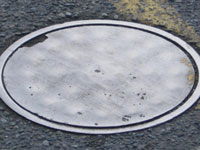Survey Monument Protection
Survey monuments are physical markers indicating the location of land boundary corners, geodetic control points, or local control points. They enable a surveyor to relate narrative boundary descriptions or improvements, and boundaries drawn on a set of plans to the actual location on the ground.
Survey Monuments Importance
All real properties, such as parcels, lots, rights-of-way, and easements can only be located or staked on the ground by starting from a monument. Legal descriptions of the horizontal and vertical locations of properties and structures all require the location of a monument as their beginning point of reference. The accuracy and relevancy of the City's Geographic Information System (GIS) maps are also based on survey monuments. The network of survey monuments protects and delineates public and private property, and is critical to the enforcement and enjoyment of real property rights. Survey monuments are important assets belonging to the City and its citizens, and are protected and maintained as such.
Locating or Identifying a Survey Monument

Example of a legible survey monument cover
Most survey monument locations can be found in the City's GIS system and on the City's Quarter Section Maps (also called Engineering Maps). The City's Survey Field Books can also help determine monument locations. These books may show how a monument was set, and what condition it was in when it was last seen. The books may also show where there may be ties to a monument, if the monument has been buried or lost.
Survey Monuments used for horizontal location are typically found in the City's Right-of-Way (ROW), typically in the center of the ROW, and most often at intersections. However, some monuments have been "offset" from their original locations for various reasons such as placement of manholes and traffic circles. Offset distances and directions can be determined from notes on the Quarter Section Maps and in Survey Field Books.
Survey Monuments for elevation control (Benchmarks) are found in the City sidewalks. There are many kinds of Survey Monuments. The newest are metal disks embedded in the pavement, sidewalk or ground. They are typically about 1 inch to 3 inches in diameter, and may be covered with a lid for added protection. They may be stamped with markings and some writing.
Seattle's Authority Over Survey Monuments
In 1969, RCW 58.24.040(8) initiated a process to protect monuments; responsibility was assigned to the local jurisdiction. W.A.C. Chapter 332-120 describes the process for protecting monuments. The Washington State Board of Registration for Professional Engineers and Land Surveyors consider non-compliance with these regulations to be a violation of law. Please see the link to the relevant Washington Administrative Code (WAC) under Links and References below. The Washington State Board of Registration for Professional Engineers and Land Surveyors consider non-compliance with these regulations to be a violation of law.
Developers' Responsibilities to Protect Survey Monuments
Anyone performing construction, maintenance, or other work in Seattle is responsible for protecting all survey monuments within the area of work. If it is necessary to disturb a survey monument, a permit must be requested in advance from the Department of Natural Resources. The developer must pay the cost of repairing or replacing the survey monument and is responsible for all contractors working for them.
Please note: Failure to comply to Washington State requirements regarding monument removal or destruction is a gross misdemeanor and is punishable by a fine of up to $5,000 and/or imprisonment of up to 1 year; and liability for the cost of reestablishment. Learn more about the law.
It is much more expensive to replace a monument (in the range of $10,000), if it was not properly located by a surveyor before it was damaged or destroyed.
When survey monuments are destroyed, removed or disturbed, the original position of these monuments must be re-established. The surveyor must find sufficient evidence to determine the original position of the missing monument, which must be legally defensible as it affects the real property rights of the City, property owners, and easements owners, who may find cause to dispute the reestablished location.
The cost to locate right-of-way, property, and easement lines escalates exponentially when monuments are destroyed. If one monument is destroyed, as many as four monuments must be located to reestablish the destroyed monument's position. Junior/Senior Rights issues, order of precedence of evidence, the history of the existing monuments, and resolving conflicting evidence must be sufficiently researched on the remaining monuments to replace the destroyed monument.
Please note that for some City permits involving work in the public right-of-way, you may be required to place a deposit with the permitting City department, if there are monuments in the area you will be working.
However, whether or not you have left a deposit with the City, you will still be liable for any damages to any survey monuments in the area you are working.
Permission to Disturb a Monument
The following information is needed to obtain permission to disturb a monument.
- Name and contact information
- Company or agency name and address
- Location of monument(s) to be damaged or destroyed, and plan to replace them (provided by Licensed Surveyor)
- Verification (after work completed) that monuments are replaced (provided by Licensed Surveyor)
Consider When Buying a Property for Development
You may want to verify that all survey monuments that help define the property boundaries actually exist, and are in good condition. It may cost up to $10,000 to replace a single physical monument. Locating a missing monument may be necessary for determining your property boundaries.
Apply for a Permit to Damage or Destroy a Monument
- Prior to beginning work in the ROW, check the GIS map on the 20th floor of the Seattle Municipal Tower or the Quarter Section map in the Engineering Vault on the 47th floor, and the physical location for any monuments that may be impacted by your work. Some monuments may be buried and require further investigation for information in Survey field books.
- Complete the 1st part of the Application to Remove or Destroy a Survey Monument with the help of a licensed surveyor, and return it to the address provided on the application. Also, send a copy of your application to SPU's Survey Section (see Contacts below.) Your application should be processed and mailed back to you within 48 hours of receipt.
- After the work in the ROW is completed, any damaged monuments must be replaced by a licensed surveyor.
- With the help of a licensed surveyor, complete and return the 2nd part of the Application to Remove or Destroy a Survey Monument, and return that to the address provided on the application. Also, send a copy of your application to SPU's Survey Section. (See contact information below.)
Avoid Unnecessary Costs or Delays

Example of an illegible survey monument cover
- The City assumes a monument exists and is intact unless shown otherwise prior to construction! Check with SPU Survey to verify whether or not monuments should exist at that location prior to construction! If an expected monument is missing, you need to notify SPU Survey to avoid being charged for replacement costs.
- The application process for a permit to destroy a monument will be processed by Washington State's Department of Natural Resources within 48 hours and mailed to the applicant.
Contact Information
- Questions about survey monuments in Seattle:
Chris Royak, PLS
Christopher.Royak@seattle.gov
Mark Kimborowicz, PLS
Mark.Kimborowicz@seattle.gov - Questions about the Application to Remove or Destroy a Survey Monument
Call (888) 902-1190 or email plso@dnr.wa.gov
Additional References
- Application to Remove or Destroy a Survey Monument
- WAC Chapters on Monument Removal or Destruction
- King County Records Office Record of Surveys
- King County Surveys Monument Protection
Legal disclaimer
This Client Assistance Memo (CAM) should not be used as a substitute for codes and regulations. The applicant is responsible for compliance with all code and rule requirements, whether or not described in this CAM.